Catholic Customs
 |
 |
 |
 |
 |
 |
 |
The Blessed Candles of Candlemas
The Feast of the Purification of Our Lady on February 2, also known as Candlemas, was an important day that marked a turning point in the year for Catholic men of the past.
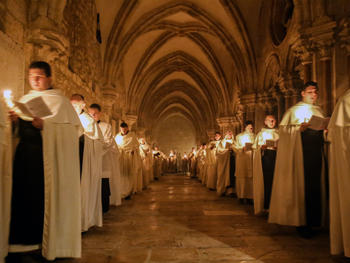
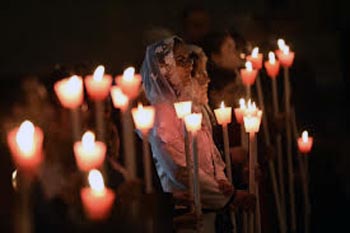 The term Candlemas comes from the custom of blessing candles and having candlelit processions on this day. In the Middle Ages, the churches would be filled with lighted candles, creating a sort of fairy world of light to honor Our Lady. Even today, many traditional Catholic parishes preserve some of these old customs.
The term Candlemas comes from the custom of blessing candles and having candlelit processions on this day. In the Middle Ages, the churches would be filled with lighted candles, creating a sort of fairy world of light to honor Our Lady. Even today, many traditional Catholic parishes preserve some of these old customs.
All of the candles to be used in the church in the coming year are blessed in a special ceremony with five prayers and the singing of the Asperges, followed by a candlelit procession. In the Middle Ages, this procession went into the churchyard past the graves of deceased parishioners offering prayers for their souls. After the procession, the Mass is said; during the Gospel and from the beginning of the Canon of the Mass to Communion the lighted candles are held by the faithful.
This procession is seen as a spiritual act of accompanying Our Lady, St. Joseph, Simeon and Anna in bringing Christ, the “light to the revelation of the Gentiles,” into the Temple. In his First Sermon On the Purification, St. Bernard says:
“The Procession of this solemnity was first made by these four, which afterwards was to be made, to the joy of the whole earth, in every place and by every nation. Let us not be surprised at its then being so little; for He whom they carried was little! Besides, all who were in it were just, and saints and perfect – there was not a single sinner!”
The faithful's use of blessed candles
In Eastern countries such as Syria and Chaldea, the sexton of the church would make the Candlemas candles of beeswax and paint them with gold. Catholics of Central and Eastern Europe decorated their handmade beeswax candles with flowers, holy images and other symbols.
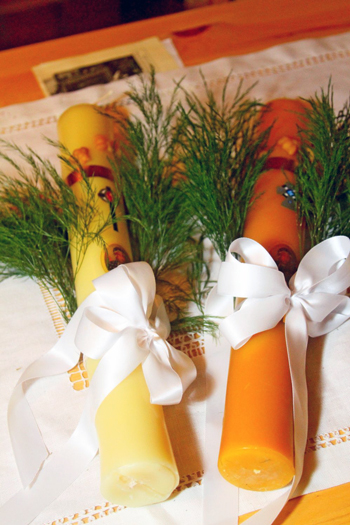
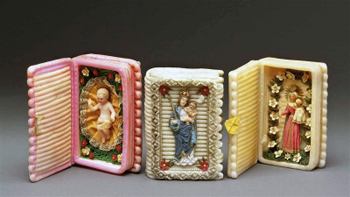 Weeks before the feast, the Polish made their long, thick Candlemas candles with beeswax and wicks of
verbascum (a sacred Slavic herb). Before bringing the candles to the church, the women adorned the candles with evergreen twigs and light blue ribbons to symbolize Our Lady.
Weeks before the feast, the Polish made their long, thick Candlemas candles with beeswax and wicks of
verbascum (a sacred Slavic herb). Before bringing the candles to the church, the women adorned the candles with evergreen twigs and light blue ribbons to symbolize Our Lady.
All Catholics used to have one blessed candle that accompanied them from Baptism until death. On Candlemas, if a new family member was expected, an extra candle would be blessed for that child. It would be their Baptismal, First Communion, Confirmation, marriage and death candle. This candle was kept by the Catholic throughout his whole life, even to the grave, where the candle was placed in the coffin. Some pious Catholics kept their blessed candle hanging over their bed as a reminder to be always ready for death.
Pious Catholics often brought multiple candles to church of different colors and sizes to be used for special purposes throughout the year. Easter, Christmas, All Saints and All Souls, being the most important feasts of the year, were honored by the presence of the bright flame of a blessed candle in many countries.
The Germans and Austrians attributed a special significance to the colors of their blessed candles. Colorful candles were used as "soul candles (or penny candles) to light for the deceased, black as weather candles to light as protection from the approaching storm, and yellow as Rosary candles, which were used on Saturdays for the Rosary." (Austrian Customs)
Many German peoples brought all of their handmade tallow candles needed for a farming year to the church to be blessed on Candlemas Day as well as wax candles for their home altars.
One charming German custom was the making of Wachsstöcke (intricately decorated wax tablets made of coiled sticks of wax) prior to Candlemas to be blessed with the other candles. These "wax sticks" were given to maids as a token of thanks and to brides before a wedding. (Austrian Customs) Holding blessed candles gave protection against wolves, storms and other maladies. Catholics believed that Our Lady protected those who carried blessed candles.
Candles for protection
Catholics all over the world lit blessed candles during storms to prevent lightning strikes, during times of sickness, during times of imminent peril on land or at sea, during difficult child births and at deathbeds. In Poland and Hungary, small pieces of blessed candles were burnt in the middle of fields to protect the whole property or buried under foundations of houses to protect the home.
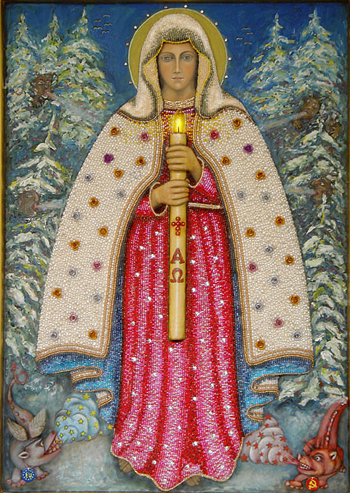
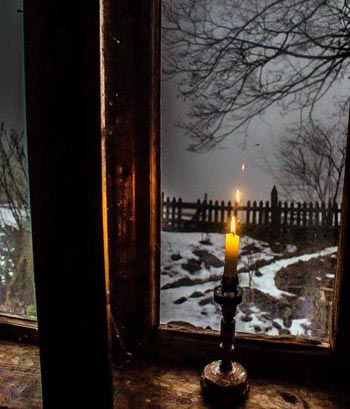 On long journeys, Catholic men often brought blessed candles along for protection. Fishermen kept a blessed candle on their boat to light during stormy weather. Many Polish farmers started every major task of the year with a blessed candle in their hand (the first sowing of the year, leading the cattle out to pasture, the beginning and ending of harvest).
On long journeys, Catholic men often brought blessed candles along for protection. Fishermen kept a blessed candle on their boat to light during stormy weather. Many Polish farmers started every major task of the year with a blessed candle in their hand (the first sowing of the year, leading the cattle out to pasture, the beginning and ending of harvest).
The Poles called Candlemas Day Święto Matki Boskiej Gromnicznej (The Feast of the Holy Mother of the Thunder Candle). The feast was so named, because the Polish peasants often invoked Our Lady under this title as the patroness of villagers and of people threatened by wolves. The Poles called the blessed candles gromnica ("thunder candles") because they were lit during storms. These candles were also lit in windows during the dark nights of winter to keep the wolves at bay.
Old Polish legends describe Our Lady walking through fields in the dark of winter carrying a candle to protect people from the wolves, to keep a watch over the crops and to light the way for weary travelers. Some Polish families kept a blessed candle burning by an image of Our Lady on Candlemas night to honor her and to implore her for protection from the wolves.
Many Catholic peoples safely guarded the flame of their candles lit at church during the procession, so that the blessed flame could be brought to the house. The French believed that " if someone could carry a Chandeleur candle all the way home from church without it going out, then that person would “certainly stay alive in the coming year.” (The Local)
In many other countries Catholics considered the task of preserving the candle flame to be essential for obtaining blessings in the year ahead.
Home ceremonies
In France and Poland, on arriving at his home on Candlemas Day, the head of the house marked a soot cross on the threshold of every doorway and window with the flame of the blessed candle. Any additional buildings on the property such as barns, stables, or sheds were blessed with incense and a small drop of the blessed wax. After this ceremony, the flame from the candle was used to light a fire of fir twigs at the hearth or stove.
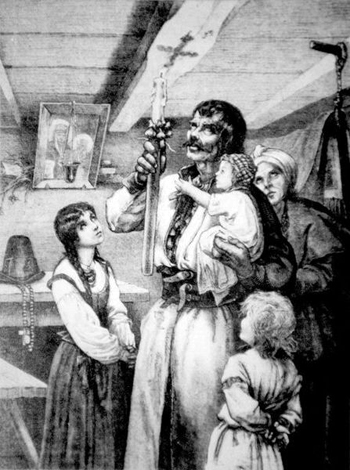 The blessed candles were kept in a safe place, often tied to the wall with a ribbon and hung next to a holy image.
The blessed candles were kept in a safe place, often tied to the wall with a ribbon and hung next to a holy image.
In German homes, the family prayed the Rosary together on the evening of Candlemas. In rural areas, the blessed candles were placed on a table together with “wax sticks” and “penny candles” for each of the deceased relatives. A few of the candles were tied to firewood shavings and lit along with one colorful “penny candle” for each member of the family who had died. On the holy water font by the door, several burning candles were placed for the salvation of those who came and went.
At the end of the Rosary, the leftover scorched shavings from the burned candles were made into crosses and hung in the stables to protect the cattle. These crosses were known as “Druden” candles because they protected people and animals from druden (night demons), who according to popular belief harmed animals and humans. The leftover wick was often eaten to protect those who ate it against throat diseases.
Restoring the customs
To our priests reading this article, we would like to unite our plea to that of Dom Guéranger, who urges a return to these good customs, especially in these modern times:
“It would be well if Pastors were to encourage this practice [of blessing candles and having Candlemas processions], retaining it where it exists or establishing it where it is not known.
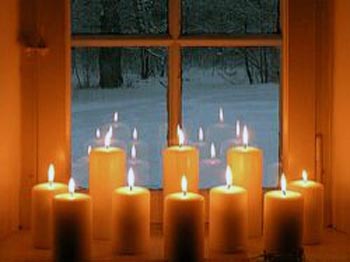 “There has been such a systematic effort made to destroy, or at least to impoverish, the exterior rites and practices of religion that we find, throughout the world, thousands of Catholics who have been insensibly made strangers to those admirable sentiments of faith, which the Church alone, in her Liturgy, can give to the body of the faithful.”
“There has been such a systematic effort made to destroy, or at least to impoverish, the exterior rites and practices of religion that we find, throughout the world, thousands of Catholics who have been insensibly made strangers to those admirable sentiments of faith, which the Church alone, in her Liturgy, can give to the body of the faithful.”
Even if the church you attend does not have a procession, it would be good to have a candlelit procession using blessed candles with your own family or community to honor Our Lady and Our Lord. Those candles can be used in all of the important events of the year, as well as during times of adversity.
The Church offers so many rich blessings through her Sacramentals that we ought to avail ourselves of these benefits. These good Candlemas customs offer the faithful a means to give glory to God by honoring the coming of the true Light Whom our flickering flames represent.
Continued
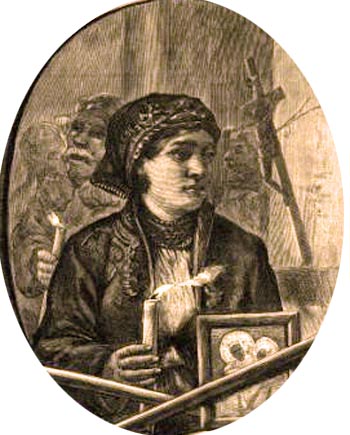

Posted February 1, 2021

German monks in a Candlemas procession; below, the faithful at Mass with their candles

All of the candles to be used in the church in the coming year are blessed in a special ceremony with five prayers and the singing of the Asperges, followed by a candlelit procession. In the Middle Ages, this procession went into the churchyard past the graves of deceased parishioners offering prayers for their souls. After the procession, the Mass is said; during the Gospel and from the beginning of the Canon of the Mass to Communion the lighted candles are held by the faithful.
This procession is seen as a spiritual act of accompanying Our Lady, St. Joseph, Simeon and Anna in bringing Christ, the “light to the revelation of the Gentiles,” into the Temple. In his First Sermon On the Purification, St. Bernard says:
“The Procession of this solemnity was first made by these four, which afterwards was to be made, to the joy of the whole earth, in every place and by every nation. Let us not be surprised at its then being so little; for He whom they carried was little! Besides, all who were in it were just, and saints and perfect – there was not a single sinner!”
The faithful's use of blessed candles
In Eastern countries such as Syria and Chaldea, the sexton of the church would make the Candlemas candles of beeswax and paint them with gold. Catholics of Central and Eastern Europe decorated their handmade beeswax candles with flowers, holy images and other symbols.

Decorated colored candles for Candlemas, below, wax sticks (Wachsstöcke) from Germany

All Catholics used to have one blessed candle that accompanied them from Baptism until death. On Candlemas, if a new family member was expected, an extra candle would be blessed for that child. It would be their Baptismal, First Communion, Confirmation, marriage and death candle. This candle was kept by the Catholic throughout his whole life, even to the grave, where the candle was placed in the coffin. Some pious Catholics kept their blessed candle hanging over their bed as a reminder to be always ready for death.
Pious Catholics often brought multiple candles to church of different colors and sizes to be used for special purposes throughout the year. Easter, Christmas, All Saints and All Souls, being the most important feasts of the year, were honored by the presence of the bright flame of a blessed candle in many countries.
The Germans and Austrians attributed a special significance to the colors of their blessed candles. Colorful candles were used as "soul candles (or penny candles) to light for the deceased, black as weather candles to light as protection from the approaching storm, and yellow as Rosary candles, which were used on Saturdays for the Rosary." (Austrian Customs)
Many German peoples brought all of their handmade tallow candles needed for a farming year to the church to be blessed on Candlemas Day as well as wax candles for their home altars.
One charming German custom was the making of Wachsstöcke (intricately decorated wax tablets made of coiled sticks of wax) prior to Candlemas to be blessed with the other candles. These "wax sticks" were given to maids as a token of thanks and to brides before a wedding. (Austrian Customs) Holding blessed candles gave protection against wolves, storms and other maladies. Catholics believed that Our Lady protected those who carried blessed candles.
Candles for protection
Catholics all over the world lit blessed candles during storms to prevent lightning strikes, during times of sickness, during times of imminent peril on land or at sea, during difficult child births and at deathbeds. In Poland and Hungary, small pieces of blessed candles were burnt in the middle of fields to protect the whole property or buried under foundations of houses to protect the home.

Holy Mother of the Thunder Candle; below, a Candlemas candle protects from storms

The Poles called Candlemas Day Święto Matki Boskiej Gromnicznej (The Feast of the Holy Mother of the Thunder Candle). The feast was so named, because the Polish peasants often invoked Our Lady under this title as the patroness of villagers and of people threatened by wolves. The Poles called the blessed candles gromnica ("thunder candles") because they were lit during storms. These candles were also lit in windows during the dark nights of winter to keep the wolves at bay.
Old Polish legends describe Our Lady walking through fields in the dark of winter carrying a candle to protect people from the wolves, to keep a watch over the crops and to light the way for weary travelers. Some Polish families kept a blessed candle burning by an image of Our Lady on Candlemas night to honor her and to implore her for protection from the wolves.
Many Catholic peoples safely guarded the flame of their candles lit at church during the procession, so that the blessed flame could be brought to the house. The French believed that " if someone could carry a Chandeleur candle all the way home from church without it going out, then that person would “certainly stay alive in the coming year.” (The Local)
In many other countries Catholics considered the task of preserving the candle flame to be essential for obtaining blessings in the year ahead.
Home ceremonies
In France and Poland, on arriving at his home on Candlemas Day, the head of the house marked a soot cross on the threshold of every doorway and window with the flame of the blessed candle. Any additional buildings on the property such as barns, stables, or sheds were blessed with incense and a small drop of the blessed wax. After this ceremony, the flame from the candle was used to light a fire of fir twigs at the hearth or stove.

A Polish father marks a beam with the cross
In German homes, the family prayed the Rosary together on the evening of Candlemas. In rural areas, the blessed candles were placed on a table together with “wax sticks” and “penny candles” for each of the deceased relatives. A few of the candles were tied to firewood shavings and lit along with one colorful “penny candle” for each member of the family who had died. On the holy water font by the door, several burning candles were placed for the salvation of those who came and went.
At the end of the Rosary, the leftover scorched shavings from the burned candles were made into crosses and hung in the stables to protect the cattle. These crosses were known as “Druden” candles because they protected people and animals from druden (night demons), who according to popular belief harmed animals and humans. The leftover wick was often eaten to protect those who ate it against throat diseases.
Restoring the customs
To our priests reading this article, we would like to unite our plea to that of Dom Guéranger, who urges a return to these good customs, especially in these modern times:
“It would be well if Pastors were to encourage this practice [of blessing candles and having Candlemas processions], retaining it where it exists or establishing it where it is not known.

Even if the church you attend does not have a procession, it would be good to have a candlelit procession using blessed candles with your own family or community to honor Our Lady and Our Lord. Those candles can be used in all of the important events of the year, as well as during times of adversity.
The Church offers so many rich blessings through her Sacramentals that we ought to avail ourselves of these benefits. These good Candlemas customs offer the faithful a means to give glory to God by honoring the coming of the true Light Whom our flickering flames represent.
Continued

Villagers carrying lit candles to Mass

Posted February 1, 2021
______________________
______________________
 |
 |
 |
 |
 |
 |


